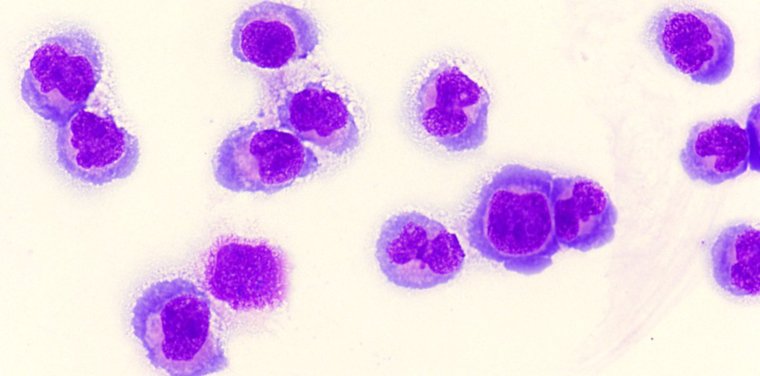A New Achilles’ Heel of Blood Cancer
Share
Acute Myeloid Leukemia (AML) is an aggressive form of blood cancer that frequently develops in children. The diseased cells often carry mutated forms of a specific gene, which is known to function within large protein networks. Researchers at CeMM and LBI-CR identified a protein of this network crucial for the survival of the cancer cells – a novel potential approach for targeted therapies. The study was published in Nature Communications.
AML is not a single disease. It is a group of leukemias that develop in the bone marrow from progenitors of specialized blood cells, the so-called myeloid cells. Rapidly growing and dividing, these aberrant cells crowd the bone marrow and bloodstream, which can be fatal within weeks or months if the disease is left untreated. Myeloid cells of various types and stages can become cancerous and cause AML, which makes the condition very heterogeneous and difficult to treat. Thus, finding drug targets that affect as many forms of AML as possible is a prime goal for researchers.
The research groups of Florian Grebien from the Ludwig Boltzmann Institute for Cancer Research, Giulio Superti-Furga, Scientific Director of the CeMM Research Center for Molecular Medicine of the Austrian Academy of Sciences, and Johannes Zuber, from the Institute of Molecular Pathology, tackled that question in their latest study. They were able to identify common, conserved molecular mechanisms that drive oncogenesis in the context of the large number of different MLL-fusion proteins by characterizing the protein-protein interaction networks of distantly related MLL fusion proteins. Their results were now published in Nature Communications (DOI:10.1038/s41467-018-04329-y)
The scientists identified the methyltransferase SETD2 as a critical effector of MLL-fusion proteins. Using genomic techniques including CRISPR/Cas9 genome editing, the researchers found that SETD2 loss caused induction of DNA-damage and ultimately cell death in the cancer cells. Moreover, SETD2 loss increased the lethal effect of Pinometostat, a drug that is currently in clinical development for treatment of leukemia patients with MLL fusions. These experiments might pave the way for a more effective therapy in the future using a combination of compounds.
Publication:
Anna Skucha, Jessica Ebner, Johannes Schmöllerl, Mareike Roth, Thomas Eder, Adrián César-Razquin, Alexey Stukalov, Sarah Vittori, Matthias Muhar, Bin Lu, Martin Aichinger, Julian Jude , André C. Müller, Balázs Győrffy, Christopher R. Vakoc, Peter Valent, Keiryn L. Bennett, Johannes Zuber*, Giulio Superti-Furga* and Florian Grebien* (*equal contribution). MLL-fusion-driven leukemia requires SETD2 to safeguard genomic integrity. Nature Communications, 2018. DOI:10.1038/s41467-018-04329-y
Funding:
The study was funded by the European Commission, the European Research Council (ERC), the Austrian Science Fund (FWF), the Austrian Research Promotion Agency (FFG), the National Institutes of Health (NIH), the National Research, Development and Innovation Office, Hungary, and Boehringer Ingelheim.

